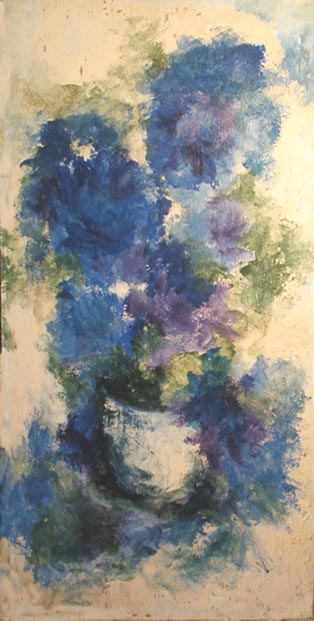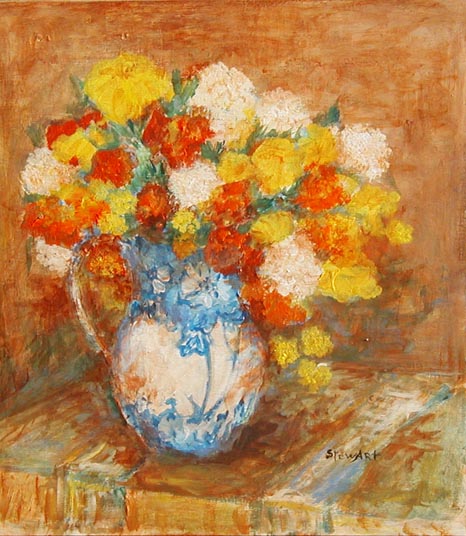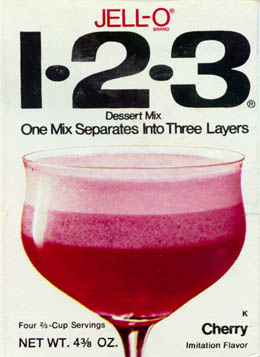|
Page A3 The Joan De Arc Crusader / Tuesday, December 24, 2002
Front Page
A1 / Editorials A2 /
Christmas
Nostalgia A4 /
Crossword
A5

The joys of "StewArt"
Long lost JDA artist resurfaces in grand style
by J. Bueker
A number of truly talented artists have played a significant role in the
cultural evolution of Joan De Arc Avenue. The paintings and woodwork of Bill
Mitchell come immediately to mind, as does the impressive artistic contribution
that Susan Bueker made when she decorated the box in which
 the Bueker's pool
table had arrived in 1969. Yet the artistic output of a certain JDA
student/housewife in the 1960s remains unmatched to this day in terms of overall
artistic quality and prolific output of product. More exciting still, this
artist has of late begun once again to produce her unique paintings, sparking a
renaissance of interest in her entire oeuvre. Local connoisseurs of the fine
arts will be thrilled to learn that Barbara Stewart has reentered the studio,
and that the results so far have been nothing less than outstanding. the Bueker's pool
table had arrived in 1969. Yet the artistic output of a certain JDA
student/housewife in the 1960s remains unmatched to this day in terms of overall
artistic quality and prolific output of product. More exciting still, this
artist has of late begun once again to produce her unique paintings, sparking a
renaissance of interest in her entire oeuvre. Local connoisseurs of the fine
arts will be thrilled to learn that Barbara Stewart has reentered the studio,
and that the results so far have been nothing less than outstanding.
Barbara Bueker Stewart began her journey of artistic greatness in a
peculiarly humble way, taking Parks and Recreation art classes with Bill
Mitchell in 1963-64, where she made her first crude attempts at composition on
her trusty easel between household chores and the maintenance of a growing
family of four children. In spite of some unsolicited (and unflattering)
criticism from a Shamrock milkman, Barbara was encouraged enough by her early
efforts to take the next step and enroll in art classes at Glendale Community
College in the mid 60s, steadily developing her technique and rubbing elbows
with other up and comers like Vince Furnier, who was destined to abandon art
school for a somewhat more successful career as a rock star named "Alice
Cooper," or some such.
Ms. Stewart's earliest works were predictably simple attempts at still life
compositions, as epitomized in a series of flower arrangements painted in
1963-64. These early efforts featured a decidedly pastel lightness and clearly
demonstrated the artist's emerging control of the fundamentals of line and
color. Stewart's work became more bold and assured as the 60s unfolded, with her
controversial nude portrait "Consuelo" and beautiful blue and white abstract
"Flowers," both executed in 1967.
The artist's career was largely put on hold for about 20 years as she
devoted herself to a very successful career teaching art to children, primarily
in the Glendale Elementary School District. Stewart rapidly developed a
reputation as a an exceedingly versatile and dedicated art teacher in the face
of disinterest and neglect among her administrative supervisors.

Upon her retirement in 1996, Stewart returned to the palette, and her mature
work reflects a refinement of artistic vision and purpose that doubtlessly
evolved from her long years of creating imaginative art teaching techniques
along with a natural progression of her refined artistic sensibility. She had
expanded her media during the 90s to include the painting of furniture and
clothing accessories, but only in the last few years has she made a serious
return to the canvas, the results of which she now whimsically signs "StewArt."
The excellence of Barbara Stewart's recent work is exemplified by "Grandma
Garner's Pitcher" (2001), a dazzling still life painted on wood and depicting a
simple blue and white decorative pitcher resting upon a tablecloth and
containing a variety of brightly colored flowers. The vibrant colors are
masterfully balanced across the canvas, and the artist constructs an
exceptionally interesting perspective, with the vanishing point of the picture
lying off of the right edge of the image, while the pitcher itself is positioned
slightly off center and presented directly facing the viewer. The blue of the
pitcher is repeated with just the appropriate degree of restraint on the
tablecloth below, and also in darker tones strategically placed in the lower
background above the table. The brownish red background is echoed in the
tablecloth as well, but expertly offset by the shimmering reds, whites, oranges
and yellows of the bouquet. Arguably, the artist's masterpiece to date.
The launching of a web site has created a renewed demand for the artist's
work, one that Stewart is struggling valiantly to satisfy. "Now everyone in the
family wants one," she laments. One may only hope that she finds the inner
strength necessary to satisfy the renewed hunger for her artistic vision.
Perhaps even that misguided Shamrock milkman, wherever he may be, is now
ready to fully appreciate the joys of "StewArt."
The art of Barbara Bueker Stewart may be viewed online on her web site at
www.barbarastew-art.com.

There was always room for Jell-O 1-2-3
by J.Bueker
The 1960s will be remembered throughout history,
among other things, as a time of cultural experimentation second to none. This
for instance was the decade when food companies first started creating
imaginative variations on their familiar and highly successful food brand names.
Sometimes it is easy to forget how this marketing strategy, which so permeates
the food business these days, was a fresh new approach to expanding a company's
market share and allotment of space on grocery store shelves.
In 1969, the good folks at General Foods introduced a bold new variety of
their extraordinarily successful "Jell-O" gelatin mix. Legend has it that
 "Jell-O 1-2-3," the Jell-O that would separate into three distinct layers as it
chilled, was discovered quite accidentally by a product research worker who was
experimenting with different combinations of "Cool Whip" (another GF product)
and Jell-O. Although the Cool Whip was easily combined with the gelatin mix and
hot water to form a sugary sweet solution, the two products were found to
naturally separate upon cooling. The interesting part of the process was that
the Cool Whip would remain partially emulsified with the Jell-O as it rose to
the top of the concoction during chilling. The ultimate result was three
separate and contiguous layers of Jell-O: pure gelatin on the bottom, a fluffy
chiffon in the middle, and a creamy layer on top. "Jell-O 1-2-3," the Jell-O that would separate into three distinct layers as it
chilled, was discovered quite accidentally by a product research worker who was
experimenting with different combinations of "Cool Whip" (another GF product)
and Jell-O. Although the Cool Whip was easily combined with the gelatin mix and
hot water to form a sugary sweet solution, the two products were found to
naturally separate upon cooling. The interesting part of the process was that
the Cool Whip would remain partially emulsified with the Jell-O as it rose to
the top of the concoction during chilling. The ultimate result was three
separate and contiguous layers of Jell-O: pure gelatin on the bottom, a fluffy
chiffon in the middle, and a creamy layer on top.
To perfect the separating process, the company substituted hydrogenated
vegetable oil, soybean lecithin and "polyglycerol esters of fatty acids" as
emulsifiers in place of the Cool Whip. While rendering the separating process
significantly more effective, these ingredients were perceptibly less flavorful
than the Cool Whip, a product that has remained popular to this day. Perhaps
this is where the entire concept of the dessert went a bit astray.
Jell-O 1-2-3 enjoyed a modest success during its first few years on the
market, but sales steadily declined and the product was discontinued by General
Foods in the late 70s. The dessert mix was reformulated and given a second run
during the mid-90s, but then disappeared again and is currently not being
produced by Kraft Foods (the successor to General Foods).
As with all Jell-O products, Jell-O 1-2-3 found its greatest popularity
among kids, who were as intrigued by the magical separating process of the
colorful liquid as they were attracted to the tart and sugary flavor of the
unique concoction. However, adults enjoyed the treat as well, and this is
evidenced by a
petition currently on the Internet urging Kraft to bring it back for a third
run. There are also
recipes available on the Web for homemade Jell-O 1-2-3, made of course from
regular Jell-O and Cool Whip.
For this writer, Jell-O 1-2-3 was a favorite snack food gimmick of
childhood. While preferring the lime flavored variety, I also enjoyed the other
flavors-- cherry, orange, strawberry and raspberry. The contrasting textures of
this sugary dish actually presented some interesting challenges for consumption,
such as attempting to eat the chiffon layer completely without touching the
gelatin. Such are the whimsical ambitions of childhood.
It was left to Carl Bueker, however, to have the first and last word on this
innovative dessert treat of yesteryear. Shortly after trying Jell-O 1-2-3 for
the first time, he was heard to remark, "Hmmm... Jell-O 1...2...3... Throw up."
_______________________________________________________________________________________________________________JDA
The Joan De Arc Crusader is compiling all the favorite old Joan De Arc
recipies from over the years for a great new Joan De Arc Cookbook! Send your
favorite Joan De Arc recipe now to:
jdacrusader@aol.com.Thank you!
Front Page
A1 / Editorials A2 /
Christmas
Nostalgia A4 /
Crossword
A5
|


 "Jell-O 1-2-3," the Jell-O that would separate into three distinct layers as it
chilled, was discovered quite accidentally by a product research worker who was
experimenting with different combinations of "Cool Whip" (another GF product)
and Jell-O. Although the Cool Whip was easily combined with the gelatin mix and
hot water to form a sugary sweet solution, the two products were found to
naturally separate upon cooling. The interesting part of the process was that
the Cool Whip would remain partially emulsified with the Jell-O as it rose to
the top of the concoction during chilling. The ultimate result was three
separate and contiguous layers of Jell-O: pure gelatin on the bottom, a fluffy
chiffon in the middle, and a creamy layer on top.
"Jell-O 1-2-3," the Jell-O that would separate into three distinct layers as it
chilled, was discovered quite accidentally by a product research worker who was
experimenting with different combinations of "Cool Whip" (another GF product)
and Jell-O. Although the Cool Whip was easily combined with the gelatin mix and
hot water to form a sugary sweet solution, the two products were found to
naturally separate upon cooling. The interesting part of the process was that
the Cool Whip would remain partially emulsified with the Jell-O as it rose to
the top of the concoction during chilling. The ultimate result was three
separate and contiguous layers of Jell-O: pure gelatin on the bottom, a fluffy
chiffon in the middle, and a creamy layer on top.